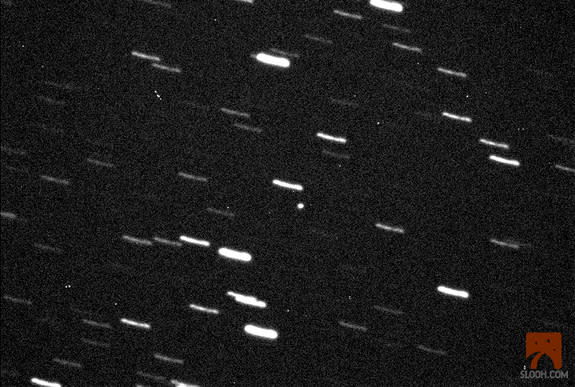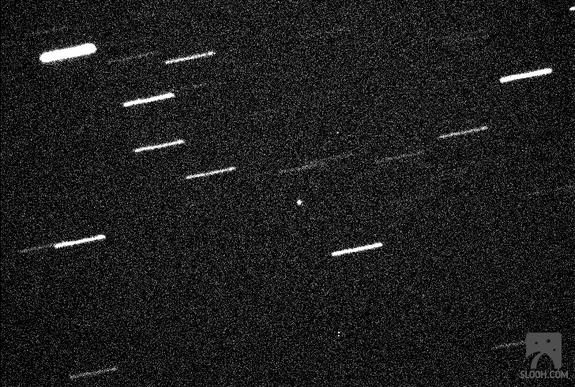Four Asteroids Buzz Earth in Single Week
In the last seven days, an asteroid 131 feet (40 meters) across and three smaller space rocks have zoomed safely by Earth, the latest demonstration that we live in a solar system that some scientists have dubbed a "cosmic shooting gallery."
All four asteroid flybys occurred between March 4 and today (March 10). The asteroids were also all discovered this month, some just days ago.
The biggest space rock encounter occurred Saturday (March 9), when the asteroid 2013 ET passed just inside 600,000 miles (965,606 kilometers) of Earth, about 2.5 times the distance between the planet and the sun. Early estimates for the asteroid suggested its size could be up to 460 feet (140 meters) across - about the size of a city block - but radar observations performed in the last several days by astronomers using NASA's Goldstone radio antenna in California revealed the smaller, 131-foot size, scientists said.
"The scary part about this one, of course, is that it's something we didn't even know about," said Patrick Paolucci, president of the online Slooh Space Camera during a live webcast of 2013 ET's flyby. The asteroid was first discovered on March 3 by the Catalina Sky Survey at the University of Arizona. [See a video of asteroid 2013 ET]
Also on Saturday, a smaller asteroid called 2013 EC20 (discovered on Thursday, March 7) came even closer to Earth, passing at a range of about 93,000 miles (150,000 km), less than half the distance to the moon. It was about 23 feet (7 m) across.
Had asteroid 2013 ET actually hit the Earth, instead of zipping safely by, it could have destroyed a large city, Slooh Space Camera engineer Paul Cox said in the webcast. Cox controlled the remotely operated Slooh telescope in the Canary Islands, off the west coast of Africa, as the asteroid zoomed by Earth at a speed of 26,000 mph (41,842 km/h).
Recent asteroid events
The asteroid flybys came a few weeks after a 55-foot (17 m) meteor exploded over Russia on Feb. 15 with the force of about 500 kilotons, injuring more than 1,200 people in the city of Chelyabinsk and causing extensive damage to city buildings. Later on Feb. 15, the larger asteroid 2012 DA14 passed within 17,200 miles (27,680 km) or Earth —closer than many communications satellites.
The asteroid 2012 DA14 flyby, which was closely tracked by NASA and astronomers, prompted planetary scientists Bruce Betts of the Planetary Society to remind the public that Earth is in a "cosmic shooting gallery" where asteroids are concerned.
"This should be a wakeup call to governments," Cox said. "We know that the solar system is a busy place. We're not sitting here on our pale blue dot, on our own in nice safety."
More space rock flybys
The two other space rocks to buzz Earth in the last week were asteroid 2013 EC and asteroid 2013 EN20, which zipped by the planet on March 4 and March 10, respectively.
The 39-foot long (12 m) asteroid 2013 EC passed Earth at about the same distance of the moon —about 238,000 miles (383,000 km). It was discovered on March 2, just two days before its closest approach. The Virtual Telescope Project, an online stargazing website in Italy run by astrophysicist Gianluca Masi, captured a video of the asteroid 2013 EC flyby.
Asteroid 2013 EN20 passed Earth today a range just beyond the moon's orbit and is about 23 feet across. It was first discovered by astronomers on March 7.
NASA scientists and astronomers around the world routinely scan the sky for large asteroids that could pose an impact threat to Earth. Small asteroids regularly zip by the planet unseen, and a flyby like that of asteroid 2013 ET may occur every few days or so, astronomer Michael Busch of the National Radio Astronomy Observatory told SPACE.com in an email.
About 100 tons of material - mostly grains of dust - fall harmlessly into Earth's atmosphere each day, NASA scientists have said.
Sightings by amateur astronomers, who can also discover near-Earth asteroids and help refine their orbits with follow-up observations, can be vital in tracking newfound space rocks.
Cox said he used the Slooh telescope to send images of asteroid 2013 ET into the Minor Planet Center operated at the Smithsonian Astrophysics Observatory in Cambridge, Mass., for that purpose.
"Amateur astronomers can have a huge input into the field of astronomy," Cox said.
This story was updated at 9:43 p.m. ET to correct the size estimate of asteroid 2013 ET based on radar observations by NASA's Goldstone antenna in California.
Email Tariq Malik at tmalik@space.com or follow him @tariqjmalik and Google+. Follow us @Spacedotcom, Facebook and Google+. Original article on SPACE.com.
Copyright 2013 SPACE.com, a TechMediaNetwork company. All rights reserved. This material may not be published, broadcast, rewritten or redistributed.



